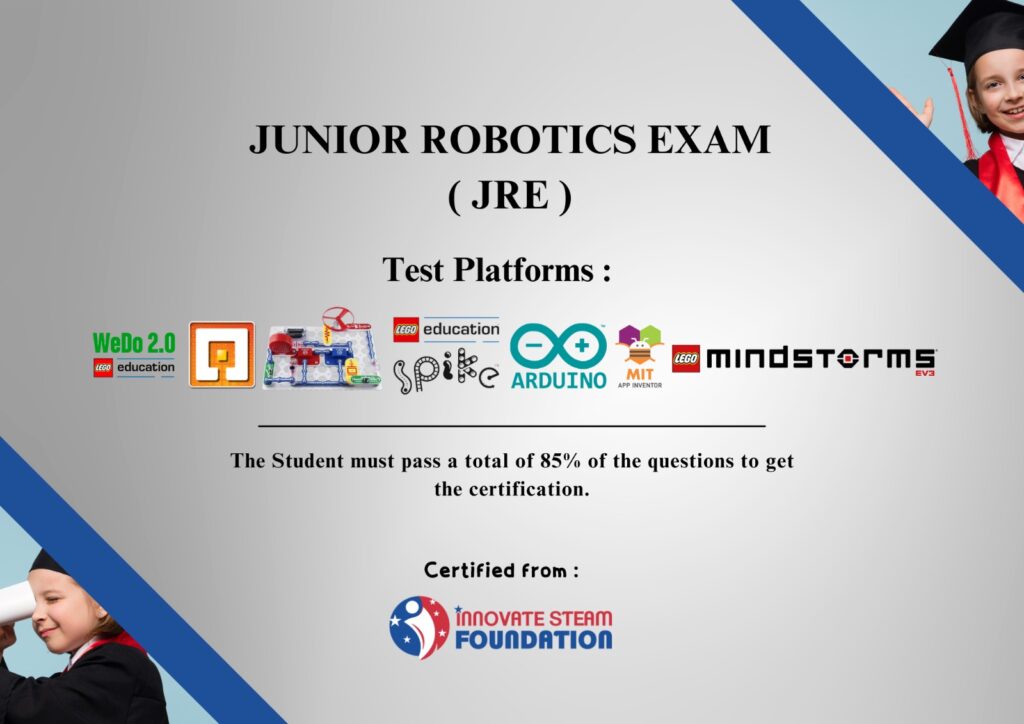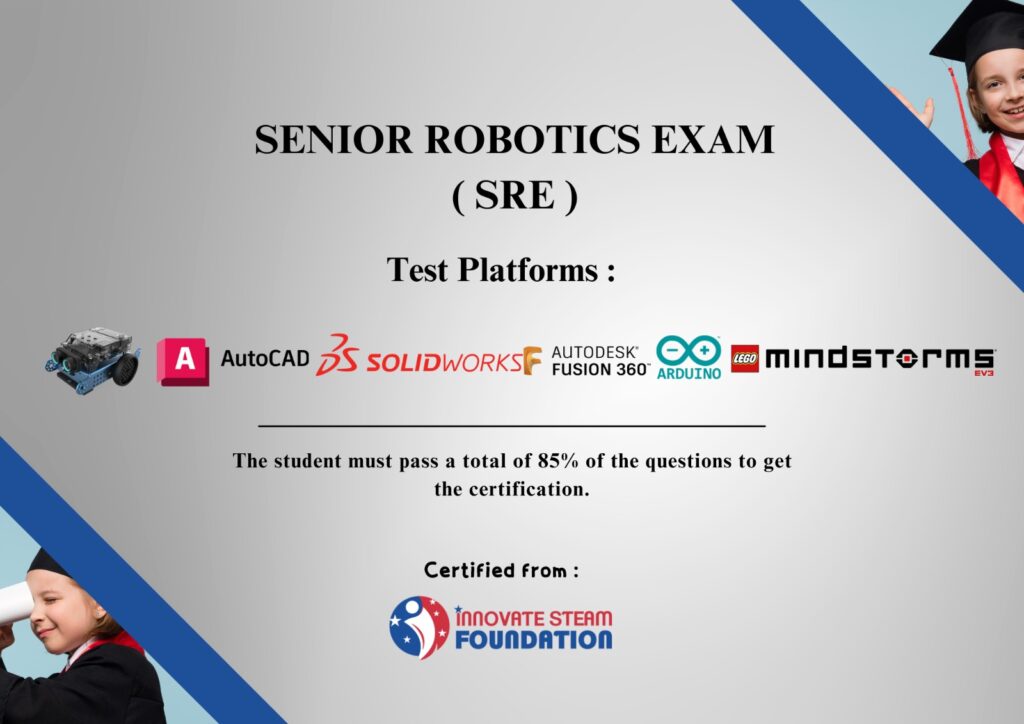INTERNATIONAL ROBOTICS EXAM (IRE)
- JUNIOR ROBOTICS TRACK EXAM
- SENIOR ROBOTICS TRACK EXAM
The Junior Robotics Track Exam is an assessment designed to evaluate the knowledge and skills of participants in the field of junior robotics. It is typically taken by students or individuals who have completed a junior robotics course or have engaged in robotics activities at a beginner level.
The exam assesses various aspects of robotics, including theoretical knowledge, practical skills, problem-solving abilities, and understanding of robotics concepts. The specific content of the exam may vary depending on the curriculum or program it is associated with, but generally, it covers the following areas:
Basic Robotics Concepts: This section tests the understanding of fundamental concepts in robotics, such as robot components, sensors, actuators, and programming basics. Questions may focus on topics like robot structure, power systems, locomotion mechanisms, and basic programming concepts.
Programming and Coding: This section evaluates the participant’s ability to write and understand code for controlling robots. It may include questions related to programming languages commonly used in robotics, such as Scratch, Python, or Blockly. Participants may be asked to write code to perform specific tasks or solve simple robotic challenges.
Problem Solving: This section assesses the participant’s ability to analyze and solve problems related to robotics. Questions may involve identifying and fixing errors in robot programs, troubleshooting hardware issues, or designing solutions for specific robotic tasks.
Robotics Applications: This section focuses on practical applications of robotics in various fields. Participants may be tested on their knowledge of how robots are used in industries like manufacturing, healthcare, or exploration. Questions may also touch upon ethical considerations and societal impacts of robotics.
Design and Construction: This section evaluates the participant’s understanding of robot design principles and construction techniques. Questions may cover topics like mechanical design, material selection, assembly methods, and safety considerations.
The Junior Robotics Track Exam aims to assess the participant’s overall understanding of robotics concepts, problem-solving skills, and practical application abilities. By successfully completing the exam, participants demonstrate their proficiency in junior-level robotics and may receive certifications or recognition for their achievements.
The Senior Robotics Track Exam is a comprehensive assessment designed to evaluate the knowledge and skills of participants in the field of robotics. It is specifically tailored for kids aged 13 to 18 who have advanced knowledge and experience in robotics and are ready to tackle more complex challenges.
The exam covers a wide range of topics and areas within robotics, testing the participant’s theoretical understanding, practical skills, problem-solving abilities, and ability to apply robotics concepts to real-world scenarios. The specific content may vary depending on the curriculum or program it is associated with, but generally, the exam covers the following areas:
Advanced Robotics Concepts: This section assesses the participant’s understanding of advanced concepts and theories in robotics. It includes topics such as robot kinematics, dynamics, control systems, computer vision, artificial intelligence, and machine learning. Participants may be asked to explain complex concepts, analyze scenarios, or solve mathematical problems related to robotics.
Programming and Algorithms: This section evaluates the participant’s programming skills and ability to develop algorithms for robotics applications. Questions may involve advanced programming languages like C++, Java, or MATLAB, and participants may be required to write code to control robots, implement navigation algorithms, or develop computer vision algorithms.
Robot Design and Construction: This section focuses on the participant’s knowledge of robot design principles, mechanical systems, and construction techniques. It may cover topics such as advanced mechanical design, sensor integration, actuator selection, and optimization of robot performance. Participants may be asked to design and build robots for specific tasks or challenges.
Robotics Applications and Challenges: This section tests the participant’s ability to apply robotics concepts to real-world applications and challenges. Questions may involve designing robotic systems for specific tasks, analyzing and optimizing robot performance, or proposing innovative solutions to current robotics challenges.
Ethical and Social Implications: This section explores the ethical considerations and societal impacts of robotics. Participants may be asked to discuss ethical dilemmas related to autonomous robots, the impact of robotics on the workforce, or considerations for designing robots that are safe and beneficial to humans.
The Senior Robotics Track Exam aims to assess the participant’s advanced knowledge and skills in robotics, as well as their ability to think critically, solve complex problems, and apply robotics concepts to real-world scenarios. It provides a comprehensive evaluation and can serve as a valuable recognition of expertise in the field of robotics for kids aged 13 to 18.


